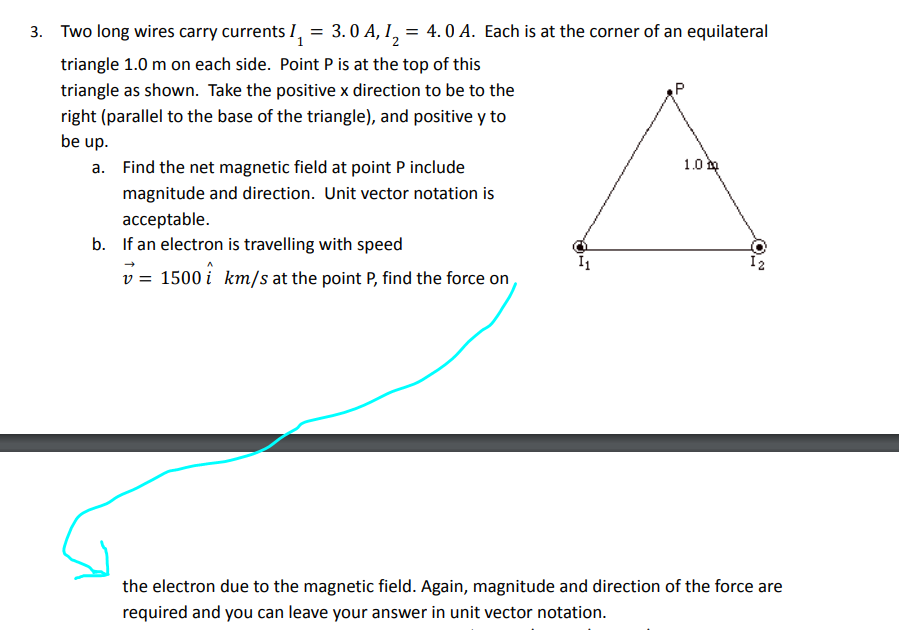3. Two long wires carry currents I, = 3.0 A, I, = 4.0 A. Each is at the corner of an equilateral triangle 1.0 m on each side. Point P is at the top of this triangle as shown. Take the positive x direction to be to the right (parallel to the base of the triangle), and positive y to be up. a. Find the net magnetic field at point P include 1.0 magnitude and direction. Unit vector notation is acceptable. b. If an electron is travelling with speed 1500 i km/s at the point P, find the force on the electron due to the magnetic field. Again, magnitude and direction of the force are required and you can leave your answer in unit vector notation.
3. Two long wires carry currents I, = 3.0 A, I, = 4.0 A. Each is at the corner of an equilateral triangle 1.0 m on each side. Point P is at the top of this triangle as shown. Take the positive x direction to be to the right (parallel to the base of the triangle), and positive y to be up. a. Find the net magnetic field at point P include 1.0 magnitude and direction. Unit vector notation is acceptable. b. If an electron is travelling with speed 1500 i km/s at the point P, find the force on the electron due to the magnetic field. Again, magnitude and direction of the force are required and you can leave your answer in unit vector notation.
Principles of Physics: A Calculus-Based Text
5th Edition
ISBN:9781133104261
Author:Raymond A. Serway, John W. Jewett
Publisher:Raymond A. Serway, John W. Jewett
Chapter22: Magnetic Forces And Magnetic Fields
Section: Chapter Questions
Problem 13OQ: Two long, parallel wires carry currents of 20.0 A and 10.0 A in opposite directions (Fig. OQ22.13)....
Related questions
Question

Transcribed Image Text:3. Two long wires carry currents I,
3.0 A, 12
= 4. 0 A. Each is at the corner of an equilateral
triangle 1.0 m on each side. Point P is at the top of this
triangle as shown. Take the positive x direction to be to the
right (parallel to the base of the triangle), and positive y to
be up.
a. Find the net magnetic field at point P include
1.0
magnitude and direction. Unit vector notation is
acceptable.
b. If an electron is travelling with speed
v = 1500 i km/s at the point P, find the force on
the electron due to the magnetic field. Again, magnitude and direction of the force are
required and you can leave your answer in unit vector notation.
(O.
Expert Solution
This question has been solved!
Explore an expertly crafted, step-by-step solution for a thorough understanding of key concepts.
This is a popular solution!
Trending now
This is a popular solution!
Step by step
Solved in 2 steps

Recommended textbooks for you

Principles of Physics: A Calculus-Based Text
Physics
ISBN:
9781133104261
Author:
Raymond A. Serway, John W. Jewett
Publisher:
Cengage Learning

College Physics
Physics
ISBN:
9781285737027
Author:
Raymond A. Serway, Chris Vuille
Publisher:
Cengage Learning

College Physics
Physics
ISBN:
9781305952300
Author:
Raymond A. Serway, Chris Vuille
Publisher:
Cengage Learning

Principles of Physics: A Calculus-Based Text
Physics
ISBN:
9781133104261
Author:
Raymond A. Serway, John W. Jewett
Publisher:
Cengage Learning

College Physics
Physics
ISBN:
9781285737027
Author:
Raymond A. Serway, Chris Vuille
Publisher:
Cengage Learning

College Physics
Physics
ISBN:
9781305952300
Author:
Raymond A. Serway, Chris Vuille
Publisher:
Cengage Learning

Glencoe Physics: Principles and Problems, Student…
Physics
ISBN:
9780078807213
Author:
Paul W. Zitzewitz
Publisher:
Glencoe/McGraw-Hill

Physics for Scientists and Engineers, Technology …
Physics
ISBN:
9781305116399
Author:
Raymond A. Serway, John W. Jewett
Publisher:
Cengage Learning

Physics for Scientists and Engineers: Foundations…
Physics
ISBN:
9781133939146
Author:
Katz, Debora M.
Publisher:
Cengage Learning